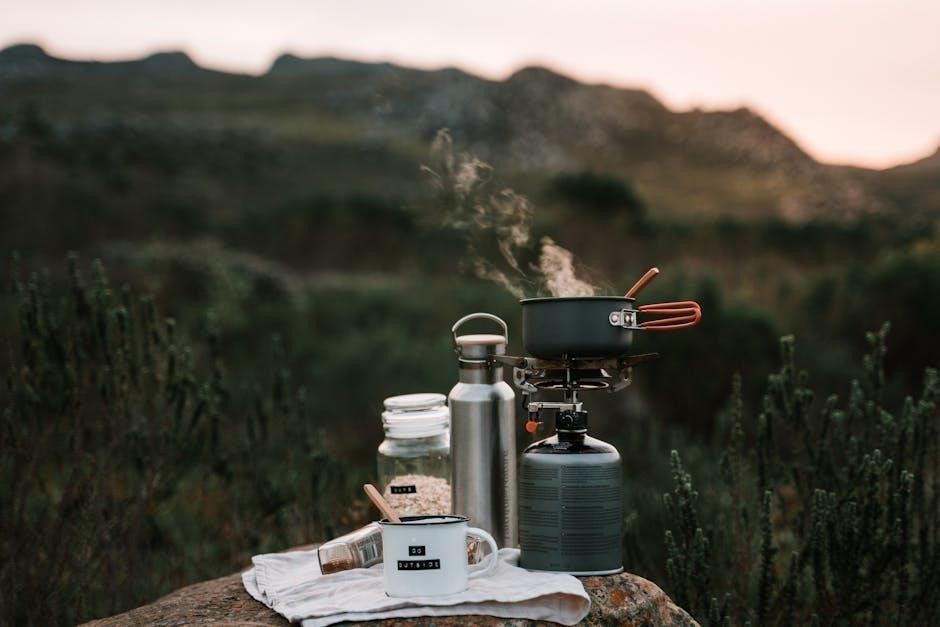The boiling method is a common technique to customize mouthpieces for a proper fit. It involves heating the mouthguard in boiling water to soften it, allowing it to mold to your teeth. This guide provides step-by-step instructions and safety tips for achieving a comfortable and secure fit using the boiling process.

The Boiling Process
Begin by boiling water in a pot, ensuring it fully submerges the mouthpiece. Submerge the mouthguard for 20-30 seconds, then remove and let it cool slightly before fitting. This softens the material for a custom mold.
Preparing the Mouthpiece
Before boiling, ensure the mouthpiece is clean and free from any debris. Trim any excess material beyond the second molars for a comfortable fit. Gather necessary tools: scissors, a boiling pot, cold water, and a towel. Place the mouthpiece in the boiling water for 20-30 seconds to soften it. Remove carefully and let it cool slightly to avoid burns. This step is crucial for achieving a proper fit and ensuring the mouthpiece molds correctly to your teeth. Proper preparation ensures safety and effectiveness during the boiling process. Follow these steps carefully to ensure optimal results. This preparation ensures the mouthpiece is ready for the boiling process and will mold correctly. Proper preparation is key to a successful fit. Ensure all steps are followed precisely for the best outcome.
Boiling the Mouthpiece
Bring a pot of water to a rolling boil. Submerge the mouthpiece completely in the boiling water and let it sit for 20-30 seconds, or as recommended by the manufacturer. Use a pair of tongs or a spoon to carefully remove the mouthpiece from the boiling water. Avoid leaving it in for too long, as this could cause it to become too soft or misshapen. Once removed, allow it to cool for a few seconds until it is warm but not scorching hot. This step is critical for softening the material to ensure it can mold properly to your teeth. Be cautious when handling the hot mouthpiece to prevent burns. Proper boiling ensures the material is pliable enough for a custom fit. Ensure the water is at a full boil before submerging the mouthpiece for optimal results. This step is essential for achieving a comfortable and secure fit. Always follow the recommended boiling time to avoid damaging the mouthpiece. Proper boiling is key to a successful fitting process.
Cooling and Fitting
After boiling, carefully remove the mouthpiece from the water using tongs or a spoon. Let it cool for about 5-10 seconds until it is warm but not scorching. Place the mouthpiece into your mouth, aligning it with your upper teeth. Bite down gently but firmly to mold it to your dental structure. Ensure it covers all necessary areas, including the gums and teeth. Hold the bite for 20-30 seconds to allow the material to set in its new shape. Remove the mouthpiece and let it cool completely before checking the fit. If adjustments are needed, repeat the boiling and fitting process. Proper cooling and fitting ensure a snug, customized fit. This step is crucial for both comfort and effectiveness. The mouthpiece should feel secure and not cause discomfort. If it does, additional trimming or another fitting may be necessary. This process ensures the mouthpiece provides adequate protection while being comfortable to wear. Proper cooling and fitting are essential for achieving the desired results.
Trimming for Comfort
After the mouthpiece has cooled and been fitted, trimming may be necessary for optimal comfort. Use sharp scissors or a craft knife to carefully remove any excess material that extends beyond your teeth or causes irritation. Pay particular attention to the edges, ensuring they are smooth and even. Avoid cutting too much at once, as this can make the mouthpiece too small. Instead, trim small amounts and test the fit repeatedly. If the mouthpiece feels bulky or digs into your gums, trimming the back edges can help. However, be cautious not to remove too much material, as this may compromise the protective coverage. Once trimmed, inspect the mouthpiece for any rough edges and smooth them with fine-grit sandpaper or a nail file. Proper trimming ensures a balance between comfort and protection, allowing the mouthpiece to stay secure without causing discomfort. This step is essential for achieving a personalized fit tailored to your needs.

Safety Precautions

When boiling a mouthpiece, ensure the water is not excessively hot to avoid damage. Use tongs or a spoon to handle the mouthpiece carefully. Avoid overheating, as it can deform the material. Always follow the manufacturer’s instructions and take necessary precautions to prevent burns or injuries during the process.
General Safety Tips
When boiling a mouthpiece, prioritize safety to avoid burns and ensure proper fitting. Always use tongs or a spoon to handle the mouthpiece, as it will be extremely hot after boiling. Never leave boiling water unattended, especially if children are nearby. Avoid overheating the mouthpiece, as excessive heat can damage the material or cause it to deform beyond repair. Ensure the water is at a rolling boil before submerging the mouthpiece, but not smoking or excessively hot. After boiling, let the mouthpiece cool slightly before attempting to bite into it to prevent burns. If you have sensitive teeth or gums, consider using a mouthguard designed for such conditions. Additionally, avoid using the boiling method if you have braces, as it may damage the orthodontic equipment or cause discomfort. Always follow the manufacturer’s guidelines and take precautions to ensure a safe and effective fitting process.
Common Mistakes to Avoid
When using the boiling method for fitting a mouthpiece, there are several common mistakes to avoid. One of the most frequent errors is overheating the mouthpiece, which can cause it to become misshapen or lose its structural integrity. Avoid leaving the mouthpiece in boiling water for too long, as this can weaken the material. Another mistake is not allowing the mouthpiece to cool down sufficiently before biting into it, which can lead to burns or discomfort. Additionally, some individuals may overtrim the mouthpiece, removing too much material and compromising its protective qualities. It’s also important not to use the boiling method if you have braces, as the heat and pressure can damage the orthodontic equipment. Neglecting to follow the manufacturer’s instructions is another common oversight, which can result in a poor fit or damage to the mouthpiece. By being aware of these pitfalls, you can ensure a safer and more effective fitting process.

When to Use the Boiling Method
The boiling method is ideal for customizing boil-and-bite mouthguards to achieve a precise fit. It’s suitable for individuals needing a snug, protective dental appliance, especially for sports or bruxism. Avoid using it with braces or damaged mouthpieces.
Suitable Scenarios
The boiling method is most effective for individuals who require a custom fit for their mouthguards, such as athletes participating in contact sports. It is also ideal for those with standard tooth alignment who need a snug fit to prevent movement during activities. Additionally, this method is beneficial for individuals who prefer a cost-effective solution over custom-made mouthguards from a dentist. The boiling process allows the mouthpiece to mold precisely to the user’s teeth, providing both comfort and protection. It is particularly recommended for people who find off-the-shelf mouthguards uncomfortable or ill-fitting. However, it is important to note that this method may not be suitable for everyone, especially those with complex dental work or specific orthodontic needs. Always consult a dentist if unsure about the suitability of the boiling method for your dental situation.
When Not to Use the Boiling Method
The boiling method is not suitable for all individuals or situations. It should not be used for mouthguards designed for people with braces, as the material may wrap around the braces and cause damage or become stuck. Additionally, this method is not recommended for custom-made mouthguards provided by dentists, as boiling can alter their precise fit; Individuals with complex dental work, such as implants or bridges, should avoid the boiling method, as it may not accommodate their specific dental needs. Furthermore, this method is not ideal for children with developing teeth, as repeated boiling can misshape the mouthguard. If the mouthpiece is not made of boil-and-bite material, boiling it can damage the product. Lastly, if the mouthguard has already been molded multiple times, boiling it again may weaken the material, leading to a poor fit. Always consult a dentist if unsure about the suitability of the boiling method for your specific dental situation.
Cleaning and Maintenance
Proper cleaning and maintenance are essential to ensure the longevity and hygiene of your boiled mouthpiece. After each use, rinse the mouthguard with cool water to remove any debris or saliva. For deeper cleaning, mix mild soap with warm water and gently scrub the mouthpiece using a soft toothbrush. Avoid using harsh chemicals, abrasive cleaners, or hot water, as they may damage the material. Rinse thoroughly and allow the mouthguard to air dry to prevent bacterial growth. Store the mouthpiece in a protective case when not in use to avoid scratches or distortions. Regularly inspect the mouthguard for signs of wear, such as thinning or cracks, and replace it if necessary. For additional sanitization, you can soak the mouthpiece in mouthwash for a few minutes, but ensure it is thoroughly rinsed afterward. Proper care will help maintain the fit and hygiene of your boiled mouthpiece, ensuring optimal protection and comfort.
